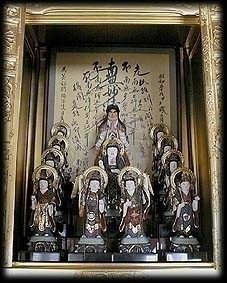Understanding
Kishimo-jin
and Other
Child-Giving Deities
 |
Understanding |
|
Thereupon there were female rakshasas, the first named Lamba, the second named Vilamba, the third named Crooked Teeth, the fourth named Flowery Teeth, the fifth named Black Teeth, the sixth named Many Tresses, the seventh named Insatiable, the eighth named Necklace Holder, the ninth named Kunti, the tenth named Spirit Snatcher. These ten female rakshasas, together with the Mother of Demon Sons [Kishimojin] and her children and followers, all went to the Buddha and with one voice said to the Buddha: "World Honored One! We, too, would protect those who read and recite, receive and keep the Law-Flower Sutra, and rid them of corroding care. If any spy for the shortcomings of these teachers of the Law, we will prevent their obtaining any chance." Whereupon in the presence of the Buddha they delivered the following spell:
"Iti me, iti me, iti me, iti me, iti me; ni me, ni me, ni me, ni me, ni me; ruhe, ruhe, ruhe, ruhe, [ruhe]; stuhe, stuhe, stuhe, stuhe, stuhe [svaha].
"Let troubles come on our heads, rather than on the teachers of the Law; neither yakshas, nor hungry ghosts...; nor fevers, whether for a single day, or quotidian, or tertian, or quartan, or weekly, or unremitting fevers; whether in male form, or female form, or form of youth, or form of a maiden, even in dreams shall ever cause distress. Whereupon before the Buddha they spoke thus in verse:
After these female rakshasas had uttered this stanza, they addressed the Buddha, saying: "World-honoured One! We ourselves will also protect those who receive and keep, read and recite, and practice this sutra, and give them ease of mind, freedom from corroding care and from all poisons."
The Buddha addressed the rakshasa women: "Good, good! Even if you are only able to protect those who receive and keep the name of the Law-Flower, your happiness will be beyond calculation; how much more if you protect those who perfectly receive, keep, and pay homage to the sutra! You and your followers should protect such teachers of the Law as these."
~The Lotus Sutra, Dharanis Chapter
This Koyasu-sama was subsequently confused either with Avalokitesvara, or with Ksitigarbha. Koyasu-Kannon (or Avalokitesvara 'giver of children') is sometimes herself confused with a 'complementary' form, identical in form and aspect, called Kishimojin, who is the representation (originally terrible but substanstially modified through the centuries) of an ogress, Hariti, converted to Buddhism, who later became a protector of children. Her image was popularized in the Kamakura period by Nichiren. In the Shingon sect, she is named Karitei-mo. She is represented seated on a chair, holding a pomegranate (Japanese zakuro) in the right hand (in Asia as well as Europe, the pomegranate is the symbol of progeniture, perhaps due to its many seeds) and surrounded with naked or semi-naked children (usually three, five, seven or nine). When represented standing, she holds a lotus, an attribute of Avalokitesvara, in the right hand. In painting, she is sometimes seated under an octagonal dais capped with a jewel. She holds a fly-wisk and has two little girls as acolytes. The most famous temples where she is worshipped are those of Meguro and Zoshigaya in Tokyo. Her followers believe that she also possesses the power of curing sick children. Her feast day is celebrated in November. |
 |